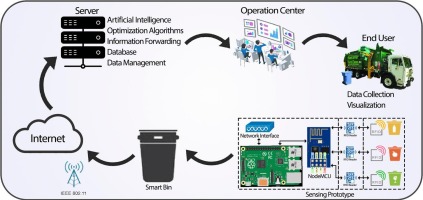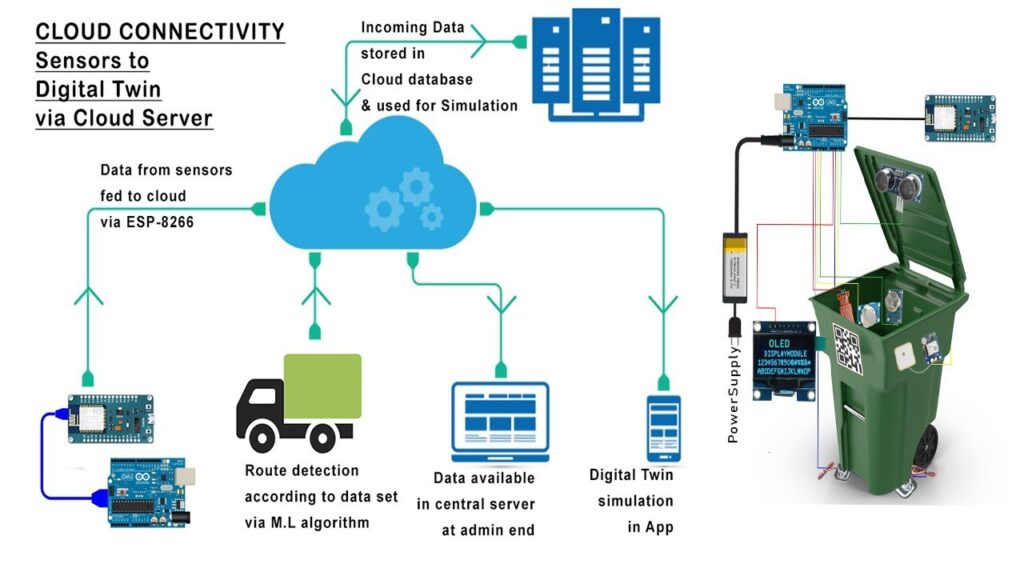Smart Waste Management System – Detailed Explanation
Introduction
Waste management is a growing challenge in both urban and rural areas, especially with the rise in population and consumerism. Traditional waste collection systems rely on fixed schedules, regardless of whether a bin is full or not. This often results in overflowing bins, inefficient collection routes, and higher operational costs.
A Smart Waste Management System uses modern electronics and Internet of Things (IoT) technology to solve this problem. It enables real-time monitoring of waste bins, ensuring timely collection, minimizing environmental pollution, and optimizing resources such as fuel and labor.

🔍 Project Concept
The core idea is to equip garbage bins with smart sensors that can detect how full they are. These bins then communicate this information wirelessly to a centralized platform (cloud server or mobile app), allowing the waste collection team to make informed decisions. This system not only helps in maintaining cleanliness but also supports environmental sustainability.

🧩 Hardware Components and Description
| Component | Description |
|---|---|
| Ultrasonic Sensor (HC-SR04) | Measures the distance from the top of the bin to the trash, indicating fill level. |
| Microcontroller (e.g., ESP8266, ESP32, or Arduino with Wi-Fi shield) | Collects data from sensors and sends it to the server. |
| Wi-Fi Module | Built into ESP8266/ESP32; used to send data to cloud or web dashboard. |
| Battery or Power Supply | Powers the system; rechargeable batteries or solar panels can be used. |
| Buzzer or LED Indicator | Gives local alerts when bin is full (optional). |
| GPS Module (Optional) | Tracks location of mobile bins or trucks. |
| Enclosure | Weatherproof casing to protect electronics inside the bin. |
⚙️ How the System Works
- Initialization:
- The system powers up and starts reading data from the ultrasonic sensor.
- It calculates the current trash level based on the distance measured from the lid to the top of the waste pile.
- Data Processing:
- The microcontroller processes the sensor reading to determine the percentage of the bin filled.
- For example, if the bin is 90% full, it is flagged for urgent collection.
- Wireless Communication:
- The ESP8266 or similar microcontroller sends the fill status data to a cloud platform, mobile app, or dashboard via Wi-Fi.
- If GPS is used, the bin’s location is also transmitted.
- Centralized Monitoring:
- A web-based dashboard or mobile app receives data from all bins and displays their status in real-time.
- Municipal workers or waste management personnel can see which bins need attention.
- Action Taken:
- Collection trucks are dispatched only to bins that are actually full, reducing unnecessary trips and saving fuel.
⭐ Key Features
- Real-Time Monitoring: Track the fill status of every bin remotely.
- Efficient Route Planning: Optimize collection routes based on which bins are full.
- Environmentally Friendly: Prevents overflow and associated health hazards.
- Cost-Efficient: Reduces fuel consumption and labor hours by eliminating unnecessary trips.
- Scalable: Easily expandable to cover hundreds or thousands of bins.
- Remote Notifications: Sends alerts via app, email, or SMS.
- Power Efficient: Can run on solar energy or low-power batteries.
📊 Software & Platforms (Optional)
- Cloud Dashboard: Built using platforms like Google Firebase, Blynk, or a custom web app.
- Mobile App: Alerts and status updates via Android/iOS applications.
- Data Logging & Analytics: Visualize trends in waste generation for smarter planning.
🏙️ Applications
- Municipal Solid Waste Management: Smart cities and urban municipalities.
- Large Campuses: Schools, universities, and industrial zones.
- Shopping Malls and Parks: Public areas with high foot traffic.
- Airports & Railway Stations: For efficient, hygienic waste handling.
- Commercial Complexes & Smart Buildings: For sustainable office waste control.
✅ Advantages
- Reduces manual labor and increases productivity.
- Helps maintain a cleaner and greener environment.
- Real-time alerts reduce response time.
- Encourages responsible waste disposal and monitoring.
- Enables future integration with AI for predictive scheduling.
🔄 Possible Upgrades
- AI-based Route Optimization: Use machine learning to predict collection patterns.
- Smart Segregation: Integrate with smart sorting systems (wet, dry, recyclable).
- Energy Harvesting: Use solar power or kinetic energy to recharge batteries.
- Integration with Smart City Infrastructure: Connect to wider urban management systems.
